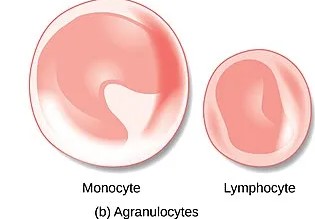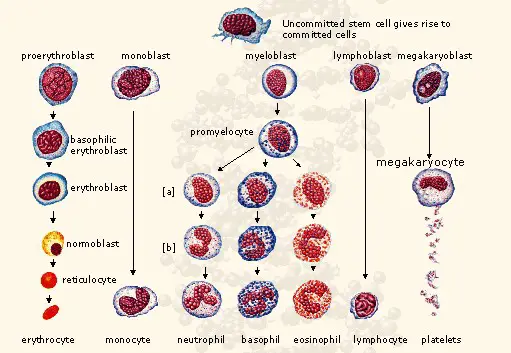Leukocytes, or white blood cells, are a pivotal component of the immune system, safeguarding the body against both infectious disease and foreign invaders. These cells come in various types, each with specific functions that play crucial roles in the body’s defense mechanisms. The distinction between granular and agranular leukocytes, based on their appearance under a microscope and their immune functions, is fundamental in understanding how the body responds to challenges to its health.
Granular leukocytes, which include neutrophils, eosinophils, and basophils, are characterized by the presence of granules in their cytoplasm. These granules contain potent enzymes and substances crucial for combating pathogens. Agranular leukocytes, namely lymphocytes and monocytes, lack these visible granules but play a pivotal role in the immune system by directly attacking pathogens or producing antibodies. This classification underpins the diverse strategies employed by the immune system to protect the body.
The distinction between these two types of leukocytes lies not just in their appearance but in their function within the immune response. Granular leukocytes are primarily involved in the immediate defense against infections, releasing enzymes and substances that neutralize pathogens. Agranular leukocytes, on the other hand, are key players in the adaptive immune response, targeting specific pathogens for destruction and providing long-term immunity. This functional diversity ensures a comprehensive defense mechanism capable of addressing a wide range of threats.

Leukocytes Overview
What Are Leukocytes?
Leukocytes, commonly known as white blood cells (WBCs), are vital components of the immune system. Their primary role is to protect the body from infections, foreign invaders, and diseases. Unlike red blood cells, leukocytes are not as numerous but play a critical role in the body’s defense mechanisms.
Leukocytes circulate through the body in the blood and lymphatic systems, constantly on the lookout for pathogens like bacteria, viruses, and fungi. When they detect these invaders, they engage in a variety of actions to neutralize or destroy them, helping to keep the body healthy.
Types of Leukocytes
Leukocytes are divided into two main types based on their appearance under a microscope and their immune functions: granular and agranular. This classification is crucial for understanding how the immune system operates and responds to threats.
Granular Leukocytes
Granular leukocytes are characterized by the presence of granules in their cytoplasm. These granules contain enzymes and substances crucial for combating pathogens. The main types of granular leukocytes are neutrophils, eosinophils, and basophils.
Agranular Leukocytes
Agranular leukocytes, on the other hand, do not have visible granules in their cytoplasm. They play a pivotal role in the immune system by directly attacking pathogens or producing antibodies. The primary types of agranular leukocytes are lymphocytes and monocytes.
Granular Leukocytes
Basics of Granular Leukocytes
Granular leukocytes are a key part of the body’s first line of defense against infectious agents. The granules in these cells contain potent biochemical substances that can destroy or neutralize pathogens.
Types of Granular Leukocytes
Neutrophils
Neutrophils are the most abundant type of white blood cells and are essential in the fight against infections, especially bacterial and fungal infections. They are among the first responders to microbial invasion.
Eosinophils
Eosinophils are vital in combating multicellular parasites and certain infections. They also play a role in allergic reactions and asthma.
Basophils
Basophils are the least common type of granular leukocyte but play significant roles in allergic reactions by releasing histamine, which contributes to inflammation.
Function and Importance
The primary function of granular leukocytes is to engage and destroy pathogens. They do this through a process called phagocytosis, where they engulf and digest microbial invaders.
- Neutrophils rapidly respond to sites of infection, using their granules to kill and digest bacteria and fungi.
- Eosinophils are crucial in fighting larger parasites like worms and also play a part in allergic responses.
- Basophils, while less understood, are known to release histamine, contributing to the inflammatory response during allergic reactions.
Agranular Leukocytes
Basics of Agranular Leukocytes
Agranular leukocytes lack visible cytoplasmic granules and are primarily involved in the adaptive immune response. They are key players in fighting infections by recognizing specific antigens and remembering past invaders.
Types of Agranular Leukocytes
Lymphocytes
Lymphocytes are the cornerstone of the adaptive immune system, with two main types: B cells and T cells. B cells are responsible for antibody production, while T cells destroy infected host cells and help regulate immune responses.
Monocytes
Monocytes are the largest type of white blood cell and can differentiate into macrophages and dendritic cells once they move into tissues. These cells are crucial in phagocytosis and in presenting antigens to lymphocytes to initiate the adaptive immune response.
Function and Importance
Agranular leukocytes are fundamental to the body’s ability to remember and specifically target pathogens.
- Lymphocytes (B cells and T cells) are pivotal in recognizing specific pathogens they have encountered before, allowing for a faster and more effective immune response upon reexposure.
- Monocytes and their derivatives are essential in the early stages of the immune response, helping to clear infections and initiate the adaptive immune response by presenting antigens to T cells.

Comparative Analysis
Physical Differences
Appearance Under a Microscope
Under the microscope, granular leukocytes show visible granules within their cytoplasm, giving them a speckled appearance. These granules are packed with enzymes and chemicals vital for the leukocytes’ defense functions. In contrast, agranular leukocytes lack these visible granules, appearing more uniform and smooth. This fundamental difference is key in the initial classification and study of leukocytes.
Functional Differences
How Each Type Responds to Pathogens
Granular and agranular leukocytes have unique ways of responding to pathogens. Granular leukocytes are often the first to arrive at the site of an infection, where they engage in phagocytosis, engulfing and neutralizing pathogens directly. On the other hand, agranular leukocytes play a crucial role in the adaptive immune response, recognizing specific antigens and orchestrating a tailored response. This includes the activation of other immune cells, production of antibodies by B cells, and direct attack on infected cells by T cells.
Clinical Significance
Diseases Associated With Each Leukocyte Type
Certain diseases and conditions can be associated with abnormalities in specific types of leukocytes. For instance, an increase in neutrophils can indicate a bacterial infection, while elevated eosinophils might suggest an allergic reaction or a parasitic infection. On the agranular side, abnormal levels of lymphocytes can indicate viral infections, autoimmune diseases, or even certain types of cancer. Understanding these associations is crucial for diagnosis and treatment planning.
Detection and Measurement
Laboratory Tests
Common Tests to Measure Leukocyte Types
The complete blood count (CBC) with differential is the standard test to measure and differentiate leukocyte types. This test provides a count of the overall number of white blood cells and percentages of each major type, allowing healthcare providers to identify abnormalities in leukocyte distribution.
Interpretation of Results
What Different Levels Suggest About Health
Interpreting the results of leukocyte measurements can provide insights into a patient’s health status. For example, a high overall leukocyte count (leukocytosis) can indicate an ongoing infection, inflammation, or even leukemia. Conversely, a low count (leukopenia) might suggest a risk for infections, a bone marrow problem, or the effects of certain medications. The specific pattern of leukocyte types can further narrow down potential issues, guiding further diagnostic and therapeutic steps.
Impact on Health
Immune System Disorders
Disorders Related to Granular and Agranular Leukocytes
Disorders of the immune system can often be traced back to issues with specific leukocyte types. Conditions like neutropenia, a shortage of neutrophils, can leave individuals more susceptible to bacterial infections. Lymphocytosis, or an excess of lymphocytes, may indicate chronic viral infections or blood cancers like lymphoma. Identifying the leukocyte type involved is critical in understanding and managing these conditions.
Treatment and Management
How Knowledge of Leukocyte Type Aids in Treatment
The specific type of leukocyte involved in a disorder can significantly influence treatment decisions. For bacterial infections characterized by high neutrophil counts, antibiotics might be the primary treatment. In contrast, diseases associated with abnormal lymphocyte counts might require antiviral medications, immunosuppressants, or even chemotherapy for cancerous conditions. Additionally, therapies might be tailored to support the immune system, such as growth factors for patients with neutropenia.

Frequently Asked Questions
What are leukocytes?
Leukocytes, or white blood cells, are the cells of the immune system that are involved in protecting the body against both infectious disease and foreign invaders. They are produced and derived from a multipotent cell in the bone marrow known as a hematopoietic stem cell. Leukocytes are found throughout the body, including in the blood and lymphatic system.
How do granular and agranular leukocytes differ?
Granular leukocytes contain granules in their cytoplasm that are visible under a microscope and are part of the body’s first line of defense against pathogens. Agranular leukocytes, lacking these granules, are crucial for adaptive immunity, targeting specific pathogens and remembering past invaders to provide long-term immunity. This distinction highlights their differing roles in the immune response.
Why is it important to know the difference between granular and agranular leukocytes?
Understanding the difference between granular and agranular leukocytes is crucial for diagnosing and treating various immune system disorders. By knowing which type of leukocyte is elevated or depleted, healthcare professionals can better determine the nature of an immune response, whether it’s against infection, inflammation, or indicative of an allergic reaction, and tailor treatments accordingly.
How are leukocytes measured in the laboratory?
Leukocytes are measured in the laboratory through a complete blood count (CBC) test, which provides detailed information on the number and types of cells in the blood, including red blood cells, white blood cells, and platelets. Differential white blood cell counts further distinguish between different types of leukocytes, offering insights into the body’s immune response and health status.
Conclusion
The nuanced roles of granular and agranular leukocytes underscore the complexity and sophistication of the body’s immune response. Granular leukocytes’ immediate action against pathogens and agranular leukocytes’ role in adaptive immunity together form a formidable defense mechanism that is vital for maintaining health and combating diseases. This article’s exploration into their differences not only highlights the intricacies of the immune system but also emphasizes the importance of these cellular warriors in protecting the body.
Understanding the distinctive roles and functions of granular and agranular leukocytes is more than academic—it’s a crucial aspect of medical science that influences diagnostic processes, treatment decisions, and the development of therapies. As research continues to unravel the complexities of the immune system, the knowledge of these leukocytes’ varied roles will remain central to advancing healthcare and improving outcomes for patients worldwide.

